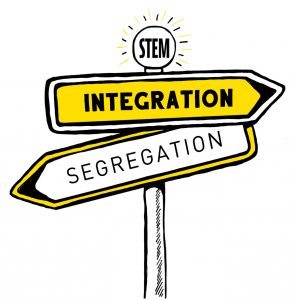An Everyday DNA blog article
Written by: Sarah Sharman, PhD, Science writer
Illustrated by: Cathleen Shaw
Science, technology, engineering, and mathematics (STEM) careers continue to grow rapidly, accounting for a quarter of the total US workforce in 2021. People of color, particularly Black women, have long been underrepresented in STEM careers. When combined, Hispanics, Blacks, and American Indians or Alaska Natives made up 24 percent of the US STEM labor force in 2021.
This lack of diversity in the STEM field persists because of a culmination of decades of discriminatory practices, robbing minority populations of access and exposure to the field. Many Black people in the STEM field cite unequal access to quality education, recruitment opportunities, promotions, and lack of encouragement from an early age. These compounding factors create an environment that is not conducive to the retention and success of Black individuals in STEM careers.
Diversity in STEM is important because people with different backgrounds bring different experiences and perspectives to the table. This leads to unique approaches to problems and the development of more innovative solutions. In honor of Black History Month, let’s examine the factors that impact and exclude Black individuals from the STEM field and discuss ways to increase their representation in the field and the quality of their experience.
What are the barriers to entry, retention, and success in STEM careers?
Lack of mentors in the field
Black scientists helped launch us into space, discovered new disease treatments, and developed world-changing technologies. However, when asked to identify career areas with prominent examples of Black achievement, Black adults rarely ranked science and engineering very high. While a few figures, like George Washington Carver, James E. Bowman, and Katherine G. Johnson, are often included in history books, the contributions of many are largely forgotten and unrecognized or credited to white male scientists.
 The lack of Black American representation robs young students of a complete picture of the history of the STEM field. It also deprives young Black students of STEM role models. Including the groundbreaking work of Black scientists in educational curricula across the country will help foster curiosity in young children to explore topics within STEM and provide Black students with figures who look like them and have likely had similar life experiences. Here we present a few of the hundreds of forgotten or overlooked Black scientists whose discoveries are still a part of our everyday lives.
The lack of Black American representation robs young students of a complete picture of the history of the STEM field. It also deprives young Black students of STEM role models. Including the groundbreaking work of Black scientists in educational curricula across the country will help foster curiosity in young children to explore topics within STEM and provide Black students with figures who look like them and have likely had similar life experiences. Here we present a few of the hundreds of forgotten or overlooked Black scientists whose discoveries are still a part of our everyday lives.
Dr. Percy Julian was born in Montgomery, Alabama, at the turn of the 19th century. He could not find a high school in the South that would accept him due to discrimination. That did not deter Dr. Julian from pursuing his dream of becoming a chemist. At 17, he applied to DePauw University in Indiana and took high school courses alongside college credits. He graduated at the top of his class. He obtained a master’s degree in organic chemistry from Harvard University and a doctorate in the chemistry of medicinal plants from the University of Vienna, Austria. He spent most of his career synthesizing important medicinal compounds from abundant plant sources, making them more affordable to mass-produce. His work was fundamental for the steroid drug industry’s production of cortisone, other corticosteroids, and birth control pills.
In 1915, Alice Ball became the first woman and African American to earn a master’s degree in chemistry at the College of Hawaii. At 24, Ball developed the first effective treatment for leprosy, which would remain the standard of treatment until the 1940s. Unfortunately, Ball died shortly after her discovery and could not publish the findings herself. A male chemist in her department continued her work, published her findings, and mass-produced the treatment. He did not give credit to Ball and renamed the technique to reflect his name. Another of Ball’s male colleagues revealed the misappropriation of the finding, but Ball remained largely forgotten in the scientific record.
Emmett Chappelle was an American scientist who grew up in Arizona in the early 1900s. He was required to attend a segregated school, where he graduated top of his class. After serving in World War II, Chappelle pursued a career in research, obtaining an associate’s degree in 1946, a Bachelor of Science in biology in 1950, and a master’s degree in biology in 1954. He spent much of his career as an exobiologist and astrochemist at NASA. There, he made one of his most well-known contributions to science, the development of the ATP fluorescent assay. The assay detects living cells by taking advantage of the firefly luciferase enzyme reaction, which uses ATP energy produced by living cells to generate visible light. The assay continues to be used by researchers worldwide. In 2007, Chapelle was inducted into the National Inventors Hall of Fame for his work on fluorescence in organisms.
Modern school segregation and systemic inequality
After the abolition of slavery in the US, several constitutional amendments were passed that granted newly freed African Americans citizenship and guaranteed them the right to vote. However, by 1896 the Supreme Court reversed all the progress Congress had made during Reconstruction by sanctioning the legal separation of races with its ruling in H.A. Plessy v. J.H. Ferguson. They decided separate but equal facilities did not violate the US Constitution’s Fourteenth Amendment.
 Despite proponents of the law touting segregated schools as equal, most were far from it because Black schools did not receive the same funding as white schools. Many Black families could not afford to have their children in school instead of working to make money for the family. As a result, by 1950, only 1 in 10 Black adults had graduated from high school compared to 4 in 10 white adults. Especially hard hit were people living in states with a history of Jim Crow laws—with Black adults in Mississippi, Georgia, and other Southern states having an average of only about five years of schooling.
Despite proponents of the law touting segregated schools as equal, most were far from it because Black schools did not receive the same funding as white schools. Many Black families could not afford to have their children in school instead of working to make money for the family. As a result, by 1950, only 1 in 10 Black adults had graduated from high school compared to 4 in 10 white adults. Especially hard hit were people living in states with a history of Jim Crow laws—with Black adults in Mississippi, Georgia, and other Southern states having an average of only about five years of schooling.
Although Brown v. Board of Education ruled state-sanctioned school segregation unconstitutional in 1954, a series of court rulings ending mandatory desegregation programs have resulted in the reemergence of many segregated schools. A study from the Civil Rights Project found that the number of schools with a majority enrollment of students of color (>90 percent of the population) has tripled since 1988. The return to segregation, although not state-enforced like pre-1954, is a return to the original problem, separate but unequal. Predominantly Black and Hispanic schools face economic, social, and structural challenges that predominantly white schools do not.
Modern school segregation often goes hand in hand with systemic inequality, which perpetuates the wealth gap between Black and white Americans, leaving many young people unable to pursue education. School enrollment is often tied to geographic zones in the US, so poorer, predominantly Black neighborhoods get zoned together. Twenty percent of students are enrolled in districts that are both poor and nonwhite, compared to only five percent of students enrolled in white districts that are equally financially challenged.
For every student enrolled, the average nonwhite school district receives about $2,000 less in government funding per student than a white school district. School districts that predominantly serve students of color received $23 billion less in funding than mostly white school districts in the United States in 2016, despite serving the same number of students.
What are the implications of unequal representation in STEM?
Including people from all walks of life brings more diverse perspectives to the big problems facing STEM today, leading to better, more efficient solutions. Although increasing numbers of black students have completed high school and enrolled in college programs over the last two decades, they also have some of the highest dropout rates and the largest debt burdens among all ethnicities. Only 15 percent of Black students who initially enrolled in a STEM major received a bachelor’s degree at graduation, compared to 30 percent of White and Asian students.
Unequal representation in STEM fields is a major setback in our drive for equality for all Americans. According to the Bureau of Labor Statistics, the number of jobs in STEM fields is projected to grow by nearly 10% between 2019 and 2029. The average salary for STEM careers is above the national average. All people should benefit from the opportunities afforded by the growing science and technology sector.
The lack of diversity in STEM is also a roadblock in the quest to increase representation for Black Americans in genetic research. Underrepresented populations being asked to participate in genetic research should be able to see that the healthcare/research field is also diverse. The honest broker strategy aims to ensure the people talking about a certain technology to a community are from the community. Seeing other Black Americans in successful positions of power in STEM builds trust among Black communities being asked to participate in genetic research.
Increasing diversity in the STEM field 
Diversifying the STEM field starts in the classroom. Even at the elementary school level, teachers can spark students’ interest in STEM and help them explore the many possibilities within the field. Creating an empowering and safe environment for all students is important for fostering such an interest in STEM. Beyond individual classrooms, it is necessary to advocate for school integration and counteract the adverse academic outcomes of segregation. Careful consideration of socioeconomic neighborhood data can help diversify school zones where zoning laws have created school segregation.
Increasing Black representation across universities, including staff and students, is important to inspire current and future students. Most Black Americans see mentors as influential in how many young people pursue STEM degrees. There must be support for personal and professional growth for Black scientists in STEM careers.
Historically black colleges and universities (HBCUs) prepare the highest number of Black American students for STEM fields. Several of Alabama’s HBCUs are recognized for their top-performing STEM departments and programs. The HudsonAlpha Institute for Biotechnology offers HBCU internships in collaboration with the Alabama Office of Minority Affairs (AOMA) and Alabama’s 14 HBCUs. The HBCU AOMA Co-op program builds a talent pipeline from HBCUs in Alabama to the state’s workforce. The year-long internships allow students to gain experience working in a lab while learning about biotechnology and related fields.
The COVID-19 pandemic drastically changed the educational landscape for several years. Students began learning online, missing out on valuable hands-on learning experiences. With the support of an NSF EPSCOR grant, HudsonAlpha provides minority students affected by the pandemic the opportunity to participate in real-world research. The year-long internship, called Boosting Retention, Interest, and Diversity through Guided Experiences in STEM (BRIDGES), allows recent college graduates the opportunity to learn critical thinking and experimental design, obtain experience in molecular biology, plant biology, and genomic technologies for measuring gene expression, and learn about career opportunities available to them in the STEM field.


